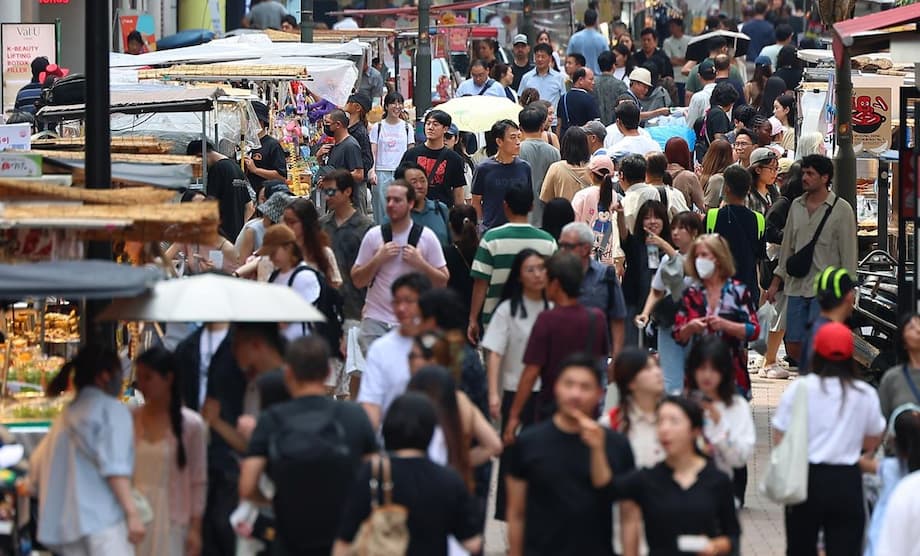Seoul sets a new peak in patient arrivals and spending
Seoul emerged as the epicenter of South Korea’s record year in medical tourism, with the capital drawing the largest concentration of international patients and driving a surge in medical spending. Nationally, the country treated 1.17 million foreign patients in 2024, a climb of 93 percent from 2023, according to the Ministry of Health and Welfare and related agencies. Roughly 85 percent of those patients received care in the Seoul metropolitan area, a reflection of the city’s dense network of clinics, university hospitals, and travel support services that cater to global visitors.
The scale-up is visible at street level. Crowds of visitors pack shopping corridors from Myeong dong to Apgujeong, many carrying clinic brochures alongside duty free bags. Currency movements and the pull of K beauty have encouraged travelers to book skin treatments, plastic surgery, and comprehensive health screenings during short stays. Government policies have lowered friction with easier visas, multilingual help, and tax refunds on approved procedures, while hospitals promote concierge style services that combine care with sightseeing.
How the numbers stack up
Annual figures compiled by the Korea Health Industry Development Institute and the health ministry show that 2024 set multiple milestones. The 1.17 million international patients treated nationwide lifted the cumulative total since 2009 to just over five million. Japan and China were the largest sources of patients, followed by the United States, Taiwan, and Thailand. Patient diversity also widened with growth from Southeast Asia, Mongolia, and Kazakhstan. Clinics delivered most services, accounting for more than four out of five visits, while Seoul and its surrounding cities hosted 85.4 percent of all foreign patients.
Spending rose in parallel. Based on overseas card payments captured by Korean processors, foreign nationals paid about 1.4 trillion won at medical providers in 2024, a per person average of roughly 1.53 million won. Wider estimates that include cash, Chinese payment platforms, and non medical travel by companions place the total at about 7.5 trillion won. Since the capital handled the bulk of patient volume, medical outlays in Seoul likely approached 860 million dollars last year. That city figure reflects the national card data and Seoul’s 85.4 percent share of patients, and excludes companion travel and cash spending.
What draws patients to Seoul clinics
Three drivers stand out in the latest wave. The global appetite for Korean beauty trends has turned dermatology into the dominant gateway. Large hospitals in the capital offer advanced imaging and surgical options that attract patients for non cosmetic needs. A weaker won against major currencies has made treatments feel meaningfully cheaper for visitors paying in dollars, euros, or yen.
K beauty and a dermatology surge
Dermatology has become the leading department for international patients. In 2024, about 705,000 foreign nationals received dermatology care in Korea, or 56.6 percent of all foreign medical visits. Fifteen years ago dermatology was a small slice of the market. Today it is the entry point for many, reflecting the worldwide reach of Korean skincare and the prominence of Seoul districts such as Gangnam and Apgujeong where clinics cluster block after block.
Popular visits include laser facials, filler and Botox sessions, scar and pigment treatments, and a growing catalog of skin boosters developed by local brands. Procedures are often scheduled in packages that fit a three to five day stay, with English, Chinese, and Japanese language support common across leading clinics. For patients who want to combine care with shopping or sightseeing, the convenience of tightly concentrated clinics is part of the draw.
High end care at competitive prices
Beyond beauty, Seoul’s university hospitals and specialty centers market strengths in cancer care, cardiology, orthopedics, and general medicine. Academic studies and international rankings point to high five year survival rates in major cancers and low mortality relative to peers. Facilities use advanced diagnostics such as PET CT, 64 slice CT, and 3.0 Tesla MRI. Surgeons employ equipment like CyberKnife and Da Vinci robotic systems. Many procedures cost less than in North America, Western Europe, or parts of East Asia, a gap that appeals to patients from the United States, Russia, Mongolia, and Kazakhstan who often seek internal medicine or full health checkups.
Hospitals and clinics increasingly bundle services that international patients value, including airport pickups, translation, medical coordinators, and digitized records for follow up with home physicians. The growing use of telemedicine follow up reduces uncertainty for those traveling long distances.
A weak won makes treatments feel discounted
The exchange rate has been a tailwind. The won slid to its weakest level in more than two years around the turn of 2025 and has remained soft, lifting foreign purchasing power. A Korea Tourism Organization field survey captured the mood among shoppers and clinic visitors.
In that survey, an Italian traveler explained the calculus behind extra purchases and treatments.
An Italian traveler surveyed by the Korea Tourism Organization said, “I kept converting prices into euros while shopping, and Korean cosmetics were much cheaper than I expected. I bought a lot as gifts.”
A Korean American tourist described how the currency affected daily spending.
A Korean American tourist told the KTO, “With my income in dollars, everything felt like it was on sale.”
The same dynamic shows up in health spending. Between December and March, foreign outlays on medical services jumped roughly 80 percent to nearly 489 billion won compared with a year earlier, led by dermatology and cosmetic procedures. The exchange rate did not only bring more visitors, it encouraged larger baskets per trip.
Where visitors come from and what they seek
The patient mix helps explain Seoul’s momentum. In 2024, Japan sent roughly 441,000 patients, China about 260,000, the United States about 101,000, Taiwan around 83,000, and Thailand about 38,000, according to KHIDI data. Japanese visitors skewed younger and female in large numbers. Demand from Russia grew despite the lack of direct flights, while Mongolia and Kazakhstan continued to send patients for checkups and specialty care.
Preferences vary by origin. Visitors from Asian neighbors tend to favor cosmetic procedures and skin care, often aligning treatments with shopping and entertainment. Patients from the United States and parts of Eurasia more often book internal medicine, orthopedics, and full screenings that require larger facilities. Clinics deliver the bulk of care across all categories, accounting for about 82 percent of visits in 2024.
Traditional Korean medicine is also drawing attention. Clinics offering acupuncture, herbal therapies, chuna manual therapy, and other holistic approaches have expanded multilingual services and customized programs for overseas patients. Many seek relief for chronic pain, rehabilitation, or wellness routines that are less available in their home systems.
Inside Gangnam clinic economy
Nowhere is the boom more concentrated than in Gangnam, especially around Apgujeong and the blocks near Gangnam Station. Rows of dermatology and plastic surgery clinics cater to international clients from opening to closing time. Retail signs highlight tax refunds on eligible procedures. Coordinators guide visitors through consultations, and many clinics assign translators who stay with patients from intake to discharge.
A nurse assistant at a busy skin clinic near Gangnam Station told the tourism agency about the shift she observed in daily traffic.
A nurse assistant at a clinic near Gangnam Station said, “Since January, about 70 percent of our patients have been foreigners coming for fillers, laser treatments and Botox. Most are from China, Japan and Thailand.”
The spending radiates beyond clinics. Data based on overseas card payments show that department stores took in about 279 billion won from these visitors, duty free shops about 188 billion won, and restaurants about 183 billion won in 2024. Korea processed more than one million tax refund claims for beauty and plastic surgery, totaling about 95.5 billion won, a signal that Seoul’s clinic districts now function as medical and retail ecosystems.
Policy push and hospital capacity
The health ministry attributes the breakneck growth to an industry plan announced in 2023 to attract more international patients, expand service quality, and cut administrative friction. The country surpassed the original goal of 700,000 foreign patients by 2027 well ahead of schedule, reaching 1.17 million in 2024 and lifting the cumulative tally since 2009 to 5.05 million.
Officials describe a push to make the ecosystem easier for visitors and safer for patients. Measures include streamlined visas, certification of hospitals that serve foreign patients, tougher oversight of brokers, and medical tourism cluster projects. The ministry has also stressed continued public support and legal updates to keep the sector competitive.
In a statement summarizing the 2024 results, the Ministry of Health and Welfare described its next steps.
The ministry said, “We will expand public support to form a sustainable industrial ecosystem and continue streamlining laws and systems to make an impact on the sector.”
Industry planners see room for further growth in 2025 as backlogs clear, airlines add capacity, and hospitals expand international centers. KHIDI officials have suggested that annual patient numbers could reach the mid one million range if travel remains stable and clinics maintain staffing.
Risks, standards, and patient safety
Rapid expansion has also revealed weak points. Investigations have documented the activities of illegal brokers who solicit customers online without the required certification, sometimes steering patients to clinics that prioritize volume over outcomes. Language and cultural barriers can lead to rushed consent or aftercare confusion. South Korea’s strict defamation laws have put pressure on unhappy patients who want to share negative experiences online, and lawsuits have been filed over critical reviews.
A handful of high profile incidents, including patient injuries and rare deaths during cosmetic procedures, have drawn warnings from foreign embassies and spurred risk advisories. A nationwide doctors strike in recent periods also created pockets of disruption, complicating postoperative care at some clinics. Public agencies and local governments have responded with safety campaigns and patient guides. The Gangnam Medical Tourism Center, for example, offers vetted referrals and licensed interpreters to help visitors assess credentials and communicate with physicians.
Experienced clinicians advise a few simple safeguards. Verify a surgeon’s specialty and license. Ask who will actually perform the procedure and what aftercare is included. Build in recovery days and make sure remote follow up is available once back home. For many travelers, those steps are the difference between a smooth short stay and regret.
Economic and urban impact
The medical surge has become a pillar of Seoul’s broader visitor economy. Between December 2024 and February 2025, more than 3.5 million foreign visitors entered Korea despite political unrest and traffic disruptions in the capital during that period, a year over year increase of nearly 20 percent. The weak won channeled spending toward clinics as well as retailers. Myeong dong, once hit hard by the pandemic, has regained its footing on the back of shoppers booking same day facials and next day checkups.
Beyond card tallies at medical providers, researchers estimate that foreign patients and their companions spent around 7.5 trillion won in 2024 across clinics, hotels, restaurants, and transportation. The benefits are concentrated around hubs such as Gangnam, Jamsil, Hongdae, and historic corridors near city center hospitals, where appointment schedules spill into late evenings and nearby stores extend hours to match.
The Bottom Line
- South Korea treated 1.17 million foreign patients in 2024, the highest on record, with 85.4 percent receiving care in the Seoul metropolitan area.
- Foreign card payments at medical providers totaled about 1.4 trillion won in 2024, putting Seoul’s estimated share near 860 million dollars.
- Dermatology led all specialties, accounting for 56.6 percent of foreign medical visits, or roughly 705,000 patients.
- Top source markets were Japan (441,000), China (260,000), the United States (101,000), Taiwan (83,000), and Thailand (38,000).
- A weak won lifted purchasing power and helped push medical spending between December and March up about 80 percent year over year.
- Clinics performed the vast majority of treatments, about 82 percent of visits, with daily crowds concentrated in Seoul’s Gangnam districts.
- Policy support includes streamlined visas, hospital certification, and tougher broker oversight, with the ministry pledging more funding and legal updates.
- Key watchpoints include illegal brokers, language gaps, strict defamation rules, and variable aftercare; city run centers offer vetted referrals and interpreters.
- Industry planners expect continued growth in 2025 if travel capacity and staffing hold steady.




